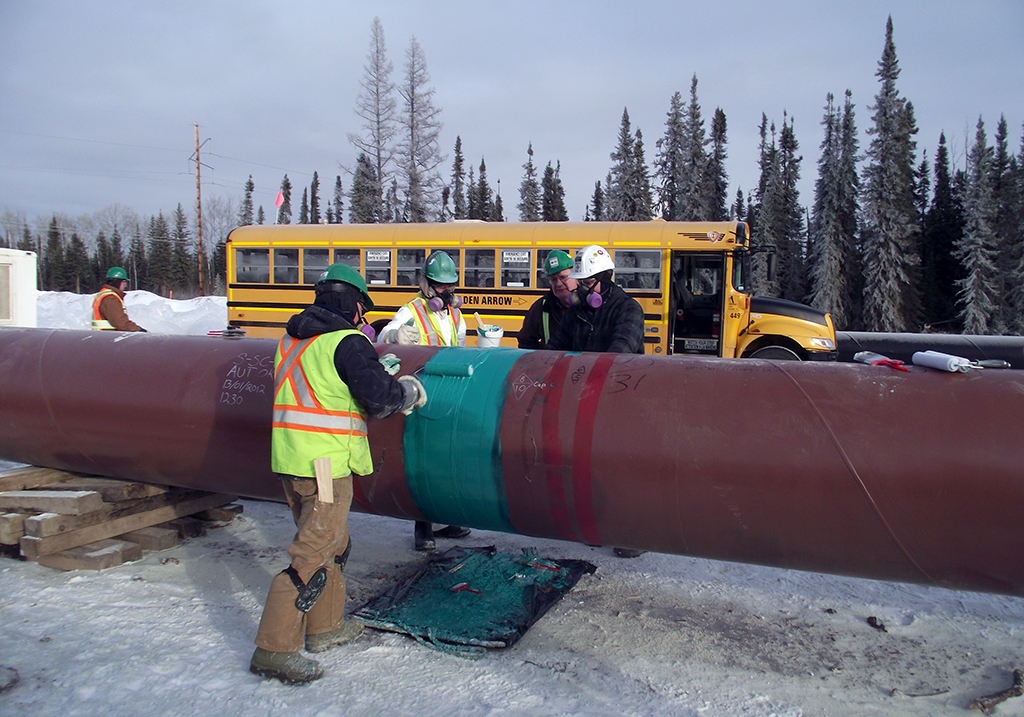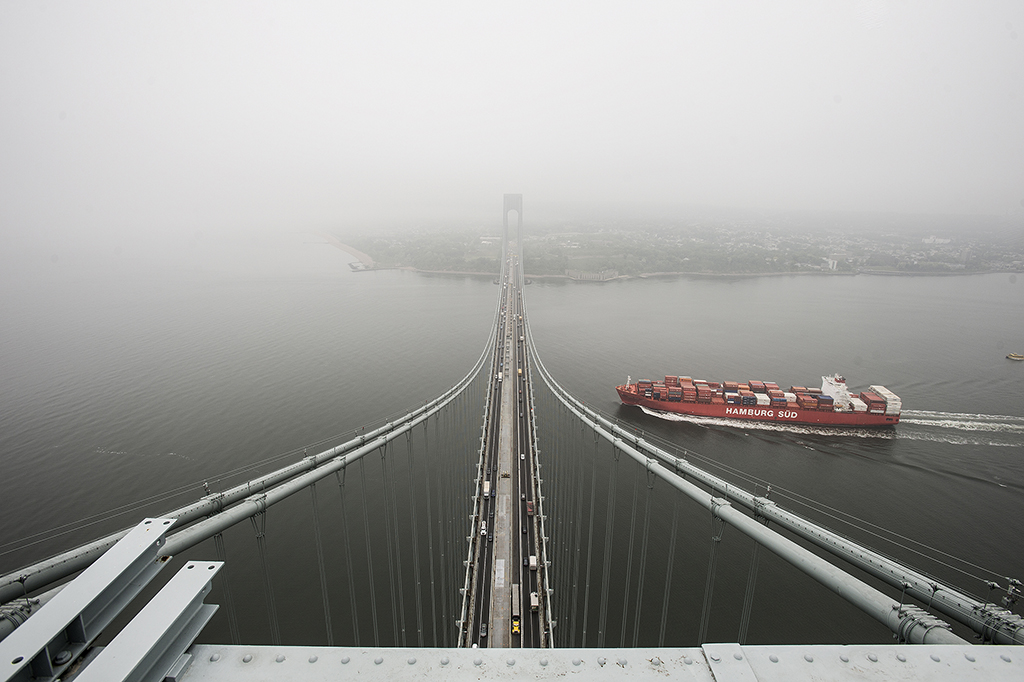Citymakers
New Yorkers working outside the public eye to address the city’s daily needs and craft its future.
We are celebrating 15 years — and counting — of stories that are deeply researched and deeply felt, that build a historical record of what the city has been.
Last year we launched a new interview series — Citymakers — to introduce you to New Yorkers working outside the public eye to address the city’s daily needs and craft its future. In the initial installments, operations manager Michael Saunders described the challenges of recycling 23 tons of e-waste a month and outdoor ad painter Jason Coatneylet us in on the unique perspective his wall work provides onto worlds below.
Today we bring you another high-flying paint authority — Joe Steele, a civil engineer and bridge inspector with KTA-Tator, Inc., specializing in industrial coatings. Bridge paint does far more than give the Williamsburg and Hell Gate Bridges their iconic pink and crimson hues; these specialized layers protect structures from the elements and help ensure their safety. The periodic maintenance of bridges — something we discussed at length with the former chief bridge officer of New York City in 2015 — requires renewal of these coatings to keep the bridges strong for years to come.
Steele makes sure this is done correctly and safely. Here he speaks with Yen Ha about the rhythm of his days, the niche industry of industrial coatings, and the certifications that make him the go-to guy on the bridge. –J.T.
What do you do?
I’m coming up on 20 years as a civil engineer. My niche is lead abatement jobs and industrial coating applications on bridges, which get sandblasted down and are then repainted. When the contract specifications come out for a project, it lists all the painting requirements. Each type of paint invokes different rules and requires different ways of preparing the surfaces. My job is to know the rules and make sure the contractor is following them.
Part of what we do is preventative maintenance. If you don’t maintain bridges, you’re going to have real problems and need to do expensive, heavy construction later on. If you can delay replacing huge steel girders and beams just by sandblasting the paint, it’s better to do that. I worked on the Brooklyn Bridge; sometimes we would start blasting then realize, once the paint is gone, that it didn’t look so good. So we would call our project managers and point out any safety issues. While there’s a contractor on site, you might as well fix it.
How did you get started in industrial coatings?
My first engineering gig out of college was inspecting asphalt for a resurfacing job in New Jersey. The resident engineer recommended I interview at his company. I hit it off with the vice president during the interview, and after three weeks of training I was working in New York. The resident engineer on the asphalt project with the old company never showed up. So I randomly ended up in industrial coatings.
What’s a typical day like in your line of work?
Contractors get to work early. Most of my projects start at 7:00am and usually end around 3:00pm. Sandblasters might work until 4:30, or if there’s a storm coming in and the contractors want to get the job done, maybe 6:00pm. The site has to be clean at the end of the day because we’re working with lead, so the vacuumers might be there until 7:30.
When I first started as an inspector, I was out there for as long the other workers were; as a chief inspector, that’s not the case anymore. Coatings have a ranges of temperatures within which they can be applied and at which they need to be stored, so I have a bunch of inspectors in the field who take temperatures periodically to make sure they are within the correct ranges. I go to the office, where we maintain all our paperwork, and I make my rounds. But every day there’s work going on, I’m out in the field. I spend time with each of those inspectors throughout the day.
You’ve got to keep an eye out, because sometimes you can’t see the forest for the trees. Another set of eyes that are a little bit removed can help spot a problem and bring it to the contractor’s attention. I make sure everyone’s on the same page and if there’s a problem or a judgment call, that’s on me.
Do you physically climb the bridges to inspect the coatings?
I have pictures from the top of the Verrazano, walking the cables, so yes! Now safety is such a huge deal that if you’re fooling around and doing some of the stuff that we all did when we were a lot younger, you’d get tossed off of a job. That’s a good thing; back then it wasn’t as stringent.
What certifications do you maintain to be able to do what you do?
I’m National Association of Corrosion Engineers (NACE) certified. It requires an initial three weeks of training and several years of field work before you can do your peer review to become fully certified. Peer review is tough because it’s high pressure. You go in a room, pick a number out of a fish bowl, and that number determines your ten questions. Six questions are technical, about things like the instruments that you use. You either know the answers or you don’t. The other four are practical, like, “If you were out in the middle of the Antarctic painting a pipeline, and X happened, what would you do?” The practical stuff is designed to see how well you think on your feet. For some situations, there are obvious wrong answers, but we have to make a lot of judgment calls. As long as you can back up your judgment calls, then you should be okay.
You have to renew NACE every five years. I’ve also taken some offshoot certifications. Contractors working with lead are required to have a person on staff called a “competent person” that knows the lead standards and has the authority to shut down a job if there’s a problem. I took a weeklong, forty-hour class to become one.
Are there many companies that specialize in industrial bridge coatings?
My company is an industry leader, and we work all over the globe. Because you know what? There are bridges all over the place. Though there are a lot more competitors than when I started, it’s still a niche. It’s so small that the resident engineer from my first paint project is actually my boss again now, even though he works for a different company; I’m technically a subcontractor to his company. It’s like a big family reunion. Probably the wisest advice that I’ve ever gotten is, “don’t burn your bridges.” I still run into people that worked with me in the past, during my first iteration as a consultant.
What are you working on now?
I’m on a three-year job on the Triborough Bridge. We’re inspecting and redoing the paint on the interior and exterior of the towers and the cables on the East River spans. What makes it different than most jobs is that we’re also doing maintenance on all the tollbooths and tunnels. The curbs and booths take a beating: people hit them, they get dinged up, and they start to look kind of crazy.
Is there something interesting or unique about your job that people don’t know about?
It’s all interesting! Between the inspectors and the bridge painters and the government employees that come out, we get to see places that nobody else gets to see. Like the top of the Verrazano — there are only a handful of people that have been up there. With the way security is now, if you’re caught out there, they’ll call in the cavalry. It didn’t used to be that way — it wasn’t wide open, but it wasn’t like it is now.
On the Triborough, it’s pretty tight because of the configuration. Think of the towers like stacked-up Pringles cans. There are not many places where you can move horizontally, but I could tell you exactly where you could get into and out of the towers — that’s cool and unique.
I have pictures from every bridge that I’ve ever worked on. So when my daughter has kids of her own, I’ll show them that before I was old and slowing up golf courses, I was climbing bridges.
The views expressed here are those of the authors only and do not reflect the position of The Architectural League of New York.
New Yorkers working outside the public eye to address the city’s daily needs and craft its future.



